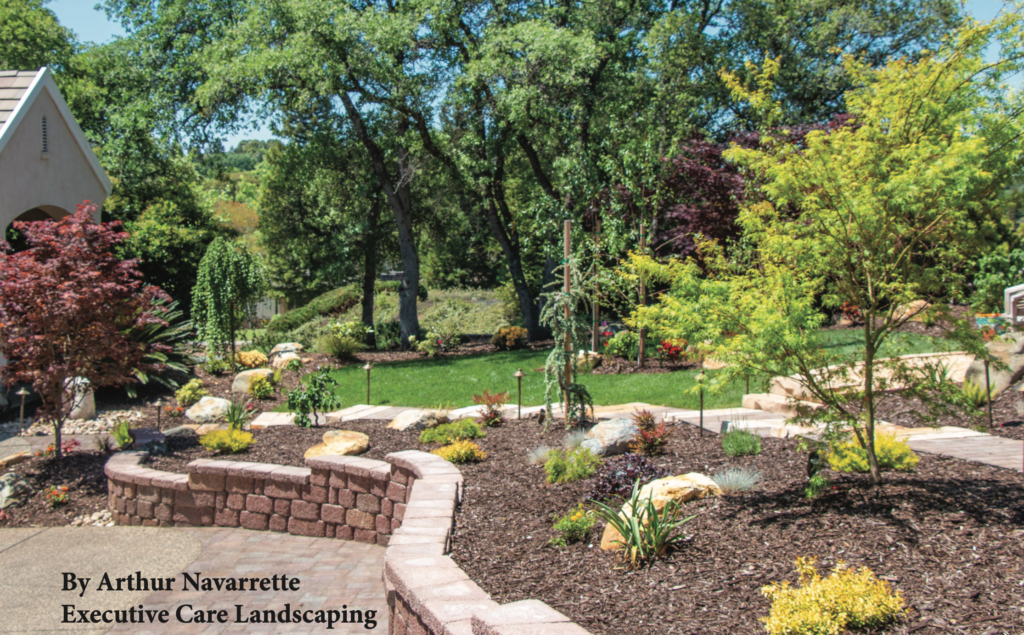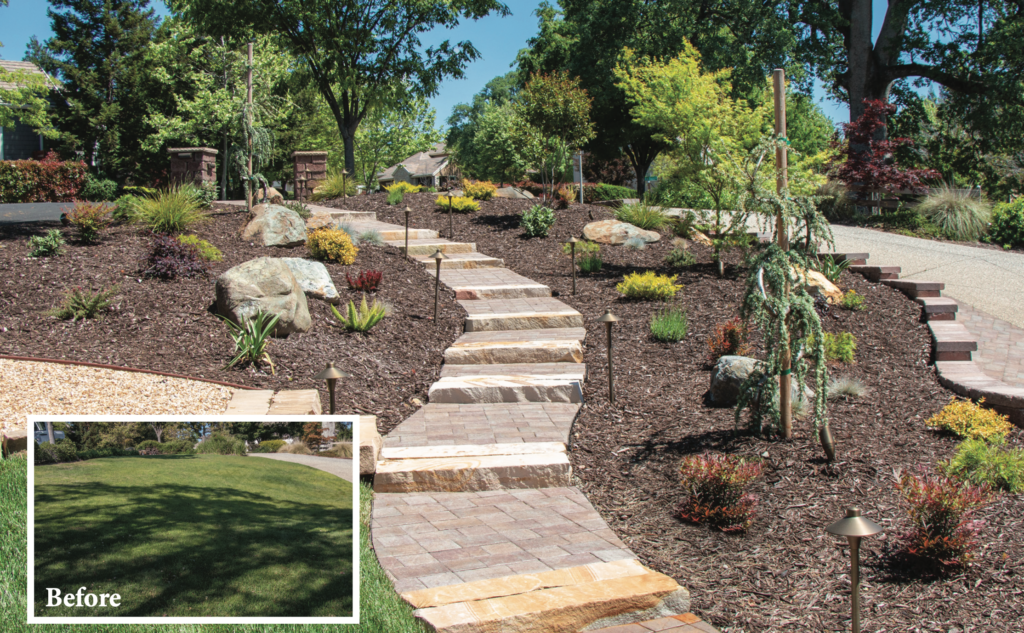For this month, we are reshowing a landscape we featured in March. The landscape is in Auburn. At that time the trees were still deciduous. The job itself, however, was completed last October/November so when we showed it in March there had been virtually no growth. The pictures we featured just showed a lot of bark, wall, pavers, lawn and tiny plants. Now the trees have leafed out, giving more life to the land- scape. Next year, it will be a very nice landscape to feature again, however I wanted to complete the hardscape portion of this land- scape before we completely forget about what we covered in March. In the first article, I discussed the pavers and the wall (our articles are posted under publications on our website). The goal was to extend the driveway so that Ben and Kathleen could pull out and drive forward. Prior, they had to back up the hill to exit their driveway. To accomplish this change, we needed to cut the hill back, build the wall, and then fill in the newly acquired space with pavers. Both block and pavers were in the San Remo color style. This was the discussion in March, only in greater detail.

As the men were completing this, the next step was to divide up the space. As you can see, prior to the change, it was just lawn, which they still wanted, however much less. How much less was up to me, however I did want Kathleen’s input. We wanted more interest and curb appeal, as a well as a sitting area.
Equally as important was access to the front door. Considering these needs, I allocated the space that would fulfill these needs. I do a lot of design work using upside down paint where I literally paint out the design on the ground. This way I can see the actual “fit.” Like pieces to a puzzle, it is important to see the space allocations as a whole, including the existing trees, house, driveway etc., which are all part of the overall view. I prefer this method over paper, though I can appreciate those of us that need paper. I find even these clients can more easily relate to “earth designs,” once I get them to trust me.
Everything that makes up a landscape plays an important role in making that landscape unique and beautiful, however with this landscape the steps were a greater asset. They were cut stone as opposed to cement, so their addition was very custom. We ordered them via a local supplier, and they in turn ordered them through a company in Idaho. This company had them in stock, but they had 24” wide as opposed to 12”s wide. Getting new ones mined and then cut to 12” would take 2 to 3 months. The only option was to get the current inventory cut, which meant the supplier had to ship them to Utah to be cut and then back to Idaho to be shipped to our local supplier. Though it was a hassle, it was less trouble than having them mined. I had to take an educated guess of how many steps we would need by determining the route I believed we would go. I did fairly well, we only had three left over.
Prior to the steps arriving, we formed the walkway by grading and adding road base. The job became more complicated when we decided to switch from flagstone to pavers in between the steps. Flagstone, being larger pieces are easier to work with and are faster to install. Pavers are great but require more time. We started the walkway at the base of the hill, and as the hill climbed upward, we would add two steps and then continue with the pavers until the elevation changed again, and then add a couple more steps, etc. At one point, we needed to add four steps to get to a more level area so we could continue with the pavers. This created an irregularity of distance between the steps. I desired four paces and then two steps, four paces and then two steps. I felt that would make for easier walking but wishes and reality don’t always agree. Also, when working with pavers in a con- fined three-foot wide space, as opposed to a patio that is much wider, a lot of cutting is involved. Pavers just don’t fit neat and tidy into a narrow area. It’s a work of love, with a lot of exact measuring.

The walk way and steps were complete, and turned out super cool. Our next challenge was the plants. In designing softscape for a slope, the angle of the slope is a big deal. If it’s particularly steep, you want to use more “creepy crawlers” as I call them. Creepy Crawlers are plants that spread out and root. They help with soil erosion, however this slope was more “lazy,” so in land- scaping it I wanted to create key focal area. In between these areas, I wanted it colorful but more relaxed before the next fo- cal area. You will notice that around the trees the landscape is a little tighter, and in between the trees the plants are a little farther apart. Right now, with the plants being young and not as yet developing their unique growing patterns, it is difficult to distinguish this pattern. It’s still a lot of bark, but in three years it will be just perfect. Viewing landscapes on hills is not the same as viewing landscapes on level ground. Depending on the steepness of the hill, the landscape can appear condensed, which makes the plants look “stacked,” though the spacing does not vary from level ground spacing. We do a lot of slopes, and by the end of the season my men and I have the best-looking legs ever.
The last point that I cover in every hill article is the irrigation. It must be overdone. If two valves can water the hill, we add a third. We want to make sure that the water pressure is more than sufficient, and we never push water uphill. In designing the system the valves themselves start at the high point meaning that the drip lines cross the hill (east to west or west to east). Landscapes, especially like this one with special features are not cheap, and forward thinking is necessary to make sure all goes well for the homeowner for years to come.
Gardeners—hopefully you have your summer vegetables in now. Keep in mind the summer is coming and a balance fertilizer is important to establish healthy roots, which leads to healthy plants. Until next time—Good Gardening
